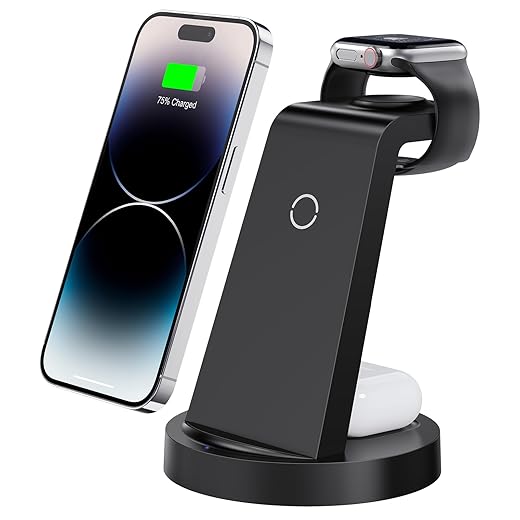








Troubleshooting Wireless Chargers for iPhone: Common Issues and Solutions
Wireless charging has revolutionized the way we power our devices, offering a convenient and tangle-free alternative to traditional charging methods. However, like any technology, wireless chargers can sometimes act up, leading to frustrating moments when you just want your iPhone to juice up. If you find yourself facing issues with your wireless charger, you're not alone. In this article, we'll explore the common problems you might encounter with wireless chargers for your iPhone and provide practical solutions to get you back on track.
Understanding Wireless Charging Technology
Before we dive into troubleshooting, it's essential to understand how wireless charging works. Essentially, wireless chargers use electromagnetic fields to transfer energy between two objects—your charger and your iPhone. This process, known as inductive charging, simplifies powering up your device but can be susceptible to various issues. Think of it like a dance: both partners need to be in sync to keep the rhythm going. When one part falters, the entire performance can fall flat.
Common Issues with Wireless Chargers
Let's take a closer look at some of the most frequently encountered problems when using wireless chargers with iPhones.
1. The Charger Isn’t Working
One of the most frustrating issues is discovering that your wireless charger seems to be doing nothing at all. You place your iPhone on the pad, and…nothing.
*Solution:* First, check the charger's power source. Is it plugged in properly? Try a different outlet or use a different cable. Sometimes, the simplest answer is the right one. If the charger has an LED indicator, make sure it's lit. If not, the charger itself might be faulty and requires replacement.
2. Slow Charging Speeds
You might notice that your iPhone charges much slower on a wireless charger compared to a wired charger. This can be especially annoying if you're in a hurry.
*Solution:* Ensure that your charger supports the appropriate wattage for your iPhone model. For optimal charging speeds, choose a charger that offers at least 7.5W for iPhones. Additionally, remove any thick cases that may interfere with the charging process. Sometimes, less is more—both in terms of case bulk and charging speed.
3. Misalignment Issues
Have you ever placed your phone down only to realize it isn't charging? This is often due to misalignment between the phone and the charger.
*Solution:* To solve this, make sure to center your iPhone on the charging pad. Some chargers even come with guides or markings to help you align your device correctly. Think of it like parking a car; a little adjustment can make all the difference.
4. Overheating Problems
Wireless chargers can sometimes get hotter than expected, leading to concerns about device safety.
*Solution:* If you notice excessive heat, remove the case from your iPhone and ensure that the charger is on a hard, flat surface to allow for proper airflow. If overheating persists, it may be time to consider a different charger. Remember, a cooler charger means a happier phone!
5. Compatibility Issues
Not all wireless chargers are created equal, and compatibility can often be a sticking point.
*Solution:* Always check that your wireless charger is compatible with your iPhone model. While most chargers follow the Qi standard, not all of them are optimized for every device. If you're unsure, refer to the manufacturer's guidelines or consult online reviews to ensure you're using the right charger.
6. Interference from Other Devices
Sometimes, other electronic devices can interfere with wireless charging. This can lead to inconsistent charging or even failure to charge altogether.
*Solution:* Keep your charging station clear of other gadgets. If you have a lot of devices near the charger, consider relocating them. Think of it as creating a quiet space for your phone to rest and recharge—free from distractions.
Conclusion
Wireless charging offers a blend of convenience and innovation for iPhone users, but it's not without its challenges. By understanding common issues and their solutions, you can enhance your charging experience and keep your iPhone powered up with ease. Whether it's ensuring proper alignment, checking compatibility, or maintaining your charger, being proactive can save you from unnecessary frustrations. So the next time you place your iPhone on a wireless charger, you can do so with confidence, knowing you've got the tools to troubleshoot any hiccups along the way.
FAQs
1. Can I use any wireless charger for my iPhone?
While most iPhones are compatible with Qi wireless chargers, it's best to use a charger that's specifically designed for your device to ensure optimal performance.
2. Is it normal for my wireless charger to get warm?
Yes, some warmth is typical during wireless charging. However, if your charger feels excessively hot, consider removing your phone case or switching to a different charger.
3. Why is my iPhone not charging on the wireless charger despite being centered?
Ensure that both the charger and your iPhone are clean and free from debris, as dirt can obstruct the charging process. If issues persist, test with another device to rule out charger malfunction.
